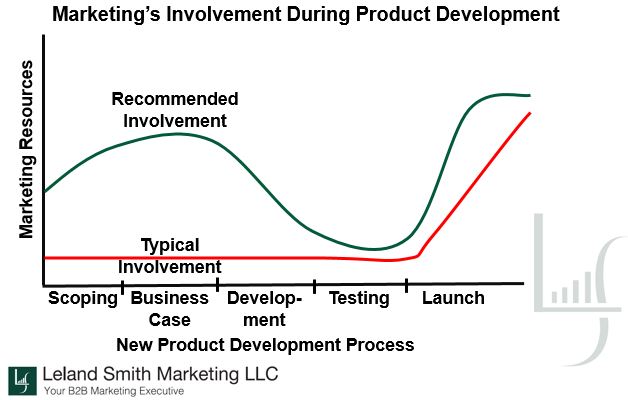Apple was not the first company to introduce an MP3 player. However when the Apple iPod was launched, it immediately became a best-seller. It was fashionable, easy-to-use and expensive. People paid a premium because of the value it brought to consumers. Apple developed this category killer not by investing in cutting-edge technology but by using existing technology to give their customers what they really wanted. The Apple iPod was a success not because of advanced engineering or operational excellence, but because of market research and a product designed to fit its customers’ needs. In other words, the Apple iPod product development process was successful because marketing was involved during the earliest stages of product development.
Waiting Until Launch Is The Wrong Time To Start Involving Marketing
Unfortunately, many businesses wait until the end of product development before they involve marketing. One engineer I was working with called me in and said they were launching a new product in 3 weeks and that “we need to market it.” To help promote the product, I started asking basic questions:
· What do customers want in this product category?
· Does this product address those needs?
· How does this product compare to the competition?
· How big is the market?
· What are anticipated sales?
Even though the product was ready to launch from a technical perspective, the client did not know the answers to these basic commercial questions. Not surprisingly, after a large investment of time and money, the product was a flop.
This situation is not unique. According to industry experts, market research in 82% of new product development projects is done poorly.1 For instance, companies often rely on voice of the salesperson or voice of the product manager instead of doing quality voice of the customer market research. Though many companies do this to shorten development times, it can often result in me-too products that are unsuccessful. This is unfortunate as many companies waste millions of dollars on capital equipment and engineering to launch a new product, but are unwilling to spend a few percent of that investment to perform quality market research to understand their customers. Given market research is generally done so poorly, it is not surprising most new products are unsuccessful.
What Should Marketing’s Role Be During New Product Development?
As indicated previously, waiting until a product is ready to launch is too late in the product development process to involve marketing. Instead, marketing’s involvement should increase and decrease during the development process.
Below is a chart showing marketing’s level of involvement over time in the new product development process. Along the horizontal axis are the typical steps found in a new product development process. Along the vertical axis is the level of involvement the marketing department has at each step of the process. The red line shows how most companies operate with marketing having minimal involvement until the product is ready to launch.
The green line, on the other hand, shows how marketing should be involved at each step. As can be seen from the chart, marketing should be heavily involved early on to during Scoping, Business Case, and Development to perform market research, define the product specifications and test product concepts with customers. In addition, marketing should be heavily involved at the end to help promote the product when it is ready to launch. In between, marketing’s involvement should decrease significantly.
The recommended approach in the above chart dramatically improves the likelihood of launching a successful product by building in the voice of the customer and performing marketing due diligence early in the development cycle while still allocating marketing resources at the end to promote the new product.
Conclusion
One of the reasons Apple was enormously successful when it launched the iPod was because marketing was involved from the earliest stages of product development. Unfortunately, most companies wait until a product is ready to launch before involving marketing. Instead, marketing should be heavily involved in the beginning of product development, decrease involvement in the middle of product development and come back strong at the end to spearhead the product launch.
1 “Winning At New Products” by Robert Cooper (c) 2011 Basic Books.


